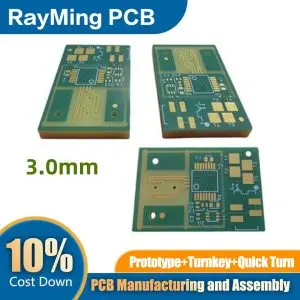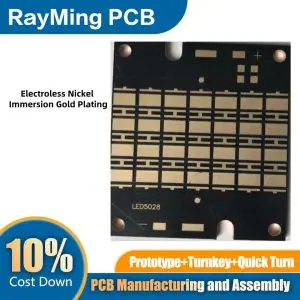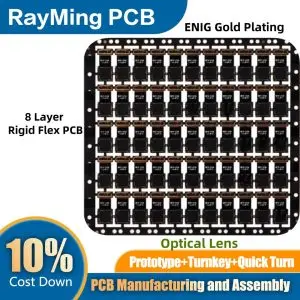In the competitive world of electronics manufacturing, selecting the right PCB surface finish is crucial for ensuring product reliability, performance, and cost-effectiveness. Among the various options available, immersion silver PCB finish has gained significant popularity due to its unique properties and benefits. This comprehensive guide explores everything you need to know about immersion silver PCB finish, from its technical specifications and cost considerations to durability factors and manufacturing best practices.
Understanding Immersion Silver PCB Finish
What Is Immersion Silver PCB Finish?
Immersion silver (ImAg) is a popular surface finish option in PCB manufacturing that involves depositing a thin layer of pure silver onto exposed copper surfaces through a chemical displacement process. During this process, copper atoms on the board surface are replaced by silver atoms from the plating solution, creating a uniform silver coating typically ranging from 0.05 to 0.15 micrometers in thickness.
The immersion silver PCB finish creates a flat, planar surface with excellent electrical conductivity and solderability characteristics. Unlike some other finishes that involve multiple metal layers, immersion silver is a single-metal finish that forms a direct interface with the underlying copper.
The Chemical Process Behind Immersion Silver Plating
The immersion silver plating process is relatively straightforward but requires precise control of chemical parameters to achieve optimal results. The basic steps include:
- Thorough cleaning of the copper surface to remove contaminants
- Micro-etching to enhance adhesion
- Pre-dip treatment to prepare the surface
- Immersion in the silver plating solution where the displacement reaction occurs
- Rinsing and anti-tarnish treatment to protect the fresh silver coating
This chemical displacement reaction is self-limiting, meaning once the copper surface is completely covered with silver, the reaction stops naturally. This self-limiting characteristic helps ensure uniformity across the entire board surface.
Benefits of Immersion Silver PCB Finish
Superior Electrical Performance
Immersion silver PCB finish offers excellent electrical conductivity, making it particularly valuable for high-frequency applications. The silver layer provides minimal signal loss and impedance control, which is crucial for RF circuits, high-speed digital designs, and other applications where signal integrity is paramount.
Outstanding Solderability
One of the primary advantages of immersion silver finish is its exceptional solderability. Fresh immersion silver surfaces exhibit near-perfect wetting characteristics with various solder alloys, creating reliable solder joints with minimal defects. This property is especially beneficial for fine-pitch components and complex assembly processes.
Planar Surface for Advanced Packaging
The immersion silver PCB finish produces a flat, uniform surface that’s ideal for advanced packaging technologies. This planar characteristic makes it particularly suitable for:
- Fine-pitch components
- Ball Grid Array (BGA) packages
- Quad Flat No-leads (QFN) components
- Other high-density interconnect technologies
The flatness ensures consistent contact across all connection points, reducing the risk of open connections or partial joints.
Environmental Compliance
Immersion silver PCB finish is fully RoHS and REACH compliant, containing no lead or other restricted substances. As environmental regulations continue to tighten globally, this compliance gives manufacturers peace of mind regarding regulatory requirements and sustainability goals.
Drawbacks and Considerations of Immersion Silver Finish

Susceptibility to Tarnishing
The most significant limitation of immersion silver PCB finish is its susceptibility to tarnishing and oxidation. When exposed to air, particularly in environments containing sulfur compounds, silver can tarnish relatively quickly, forming silver sulfide (Ag₂S). This tarnishing can affect solderability if not properly managed.
Several factors can accelerate the tarnishing process:
- High humidity
- Elevated temperatures
- Presence of sulfur compounds (including those from cardboard packaging)
- Fingerprint oils and other contaminants
Limited Shelf Life
Compared to alternative finishes like ENIG (Electroless Nickel Immersion Gold), immersion silver PCB finish has a shorter shelf life, typically ranging from 6 to 12 months under optimal storage conditions. Beyond this period, the solderability may start to deteriorate as the silver layer tarnishes.
Handling Sensitivity
Immersion silver requires careful handling throughout the manufacturing process. The silver surface is relatively soft and can be damaged by scratching or abrasion. Additionally, direct contact should be avoided as fingerprint oils can accelerate tarnishing in the contacted areas.
Immersion Silver vs. Other PCB Surface Finishes
Immersion Silver vs. ENIG
When comparing immersion silver PCB to ENIG (Electroless Nickel Immersion Gold), several key differences emerge:
| Aspect | Immersion Silver | ENIG |
| Cost | Lower | Higher |
| Shelf life | 6-12 months | 12+ months |
| Flatness | Excellent | Good |
| Wire bonding | Not suitable | Excellent |
| Thickness | 0.05-0.15 µm (single layer) | 3-6 µm Ni + 0.05-0.1 µm Au (dual layer) |
| Solderability | Excellent when fresh | Very good, more consistent over time |
| Environmental impact | Lower (no nickel) | Higher (contains nickel) |
While ENIG offers better longevity and corrosion resistance, immersion silver provides superior electrical performance and is more cost-effective for many applications.
Immersion Silver vs. HASL
Hot Air Solder Leveling (HASL) has been a traditional finish for decades, but immersion silver offers significant advantages in certain applications:
| Aspect | Immersion Silver | HASL |
| Fine-pitch capability | Excellent | Poor |
| Surface planarity | Highly planar | Uneven (solder bumps) |
| Lead content | Lead-free | Can contain lead (leaded version) |
| Cost | Moderate | Lower (for leaded version) |
| Process complexity | Moderate | Higher (thermal stress) |
| Electrical performance | Excellent | Good |
Immersion silver PCB finish is the clear winner for applications requiring fine-pitch components or planar surfaces, while HASL may still be preferred for less demanding, cost-sensitive applications.
Immersion Silver vs. OSP
Organic Solderability Preservative (OSP) is another popular lead-free option that competes with immersion silver:
| Aspect | Immersion Silver | OSP |
| Multiple reflow capability | Good | Limited |
| Visual inspection | Easy (visible pads) | Difficult (transparent coating) |
| Electrical testing | Excellent | Challenging |
| Cost | Moderate | Lower |
| Environmental impact | Higher (silver waste) | Lower |
| Shelf life | 6-12 months | 3-6 months |
OSP may be more economical, but immersion silver offers better electrical characteristics and easier testing and inspection capabilities.
Cost Analysis of Immersion Silver Finish

Typical Price Range
The cost of immersion silver PCB finish typically falls in the middle range compared to other surface finishes:
- More expensive than HASL and OSP
- Less expensive than ENIG and ENEPIG
- Approximately $0.10 to $0.25 per square inch premium over bare copper
For a standard 4-layer PCB design, immersion silver might add about 10-15% to the overall board cost compared to the most basic finishes.
Cost-Influencing Factors
Several factors can influence the final price of immersion silver PCB finish:
- Board complexity: More complex designs with higher copper layer counts generally result in higher plating costs
- Production volume: Larger production runs benefit from economies of scale
- Board thickness: Thicker boards require more plating materials
- Surface area ratio: The ratio of copper surface area to board size affects material usage
- Quality requirements: Tighter specifications may require additional process controls
- Geographic location: Manufacturing costs vary significantly by region
Total Cost of Ownership Considerations
When evaluating the cost-effectiveness of immersion silver PCB finish, manufacturers should consider the total cost of ownership, not just the initial plating cost:
- Assembly yield: Superior solderability can reduce assembly defects and rework
- Storage requirements: Special packaging may be needed to prevent premature tarnishing
- Shelf life limitations: May lead to waste if production delays occur
- Electrical performance: Higher signal integrity can reduce other design costs
Read more about:
Durability and Shelf Life of Immersion Silver PCB
Expected Lifespan
With proper handling and storage, immersion silver PCB finish typically offers:
- Shelf life before assembly: 6-12 months
- In-service lifespan: 5+ years in controlled environments
- Solderability window: Excellent for 3-6 months, then gradually declining
Factors Affecting Durability
Several environmental and handling factors can significantly impact the durability of immersion silver PCB finish:
- Humidity levels: Higher humidity accelerates tarnishing
- Temperature: Elevated temperatures speed up oxidation reactions
- Atmospheric contaminants: Sulfur compounds are particularly problematic
- Handling practices: Fingerprints introduce oils that promote localized corrosion
- Packaging materials: Some packaging can release corrosive compounds
Extending Silver Finish Longevity
To maximize the lifespan of immersion silver PCB finish, consider these preservation strategies:
- Anti-tarnish coatings: Apply specialized organic coatings to protect the silver surface
- Humidity-controlled storage: Maintain relative humidity below 50%
- Sulfur-free packaging: Use packaging materials tested to be free of sulfur compounds
- Vacuum-sealed bags: Limit exposure to atmospheric oxygen and contaminants
- Temperature control: Store at moderate temperatures (15-25°C)
Best Practices for Manufacturing with Immersion Silver

Design Considerations
When designing PCBs with immersion silver finish in mind, follow these best practices:
- Pad design: Optimize pad geometries for the superior planarity of immersion silver
- Soldermask clearance: Design appropriate clearances to prevent soldermask interaction with the finish
- Trace width: Take advantage of silver’s excellent conductivity for potential size reductions
- Thermal relief: Design appropriate thermal relief connections for large copper areas
- Test points: Include dedicated test points that can tolerate probe contact without damaging the finish
Storage and Handling Recommendations
Proper storage and handling are critical for maintaining the quality of immersion silver PCB finish:
- Store in moisture barrier bags with desiccant and humidity indicator cards
- Maintain controlled environment with 30-50% relative humidity
- Avoid direct handling of the silver surface; use gloves when necessary
- Keep away from sulfur-containing materials (including rubber bands and some papers)
- Minimize exposure to air and light when not in use
Assembly Process Guidelines
During PCB assembly, these guidelines help ensure optimal results with immersion silver finish:
- Minimize delay time: Assemble boards as soon as possible after unpacking
- Reflow profile: Use optimized reflow profiles that consider the characteristics of silver
- Flux selection: Choose fluxes compatible with immersion silver (typically mild organic acids)
- Handling equipment: Ensure pick-and-place equipment is calibrated to handle boards gently
- Post-assembly cleaning: Remove all flux residues to prevent long-term reliability issues
Contamination Prevention
Preventing contamination is especially important for immersion silver PCB finish:
- Control the assembly environment to minimize dust and airborne contaminants
- Use clean, sulfur-free gloves when handling boards
- Implement proper ESD controls throughout the manufacturing process
- Keep boards in their protective packaging until needed
- Perform regular maintenance on assembly equipment to prevent oil or lubricant contamination
Applications of Immersion Silver PCBs

High-Frequency Applications
Immersion silver PCB finish excels in high-frequency applications due to its excellent signal integrity and low insertion loss:
- RF communication systems
- Wireless networking equipment
- Satellite communication systems
- Radar systems
- High-speed digital interfaces
The minimal skin effect and low signal distortion make immersion silver an excellent choice for demanding high-frequency designs.
Consumer Electronics
Many consumer electronic devices benefit from immersion silver PCB finish:
- Smartphones and tablets
- Smart home devices
- Audio equipment
- Gaming consoles
- Digital cameras
The excellent solderability and fine-pitch capability support the miniaturization trends in consumer electronics.
Automotive Electronics
The automotive industry increasingly uses immersion silver PCB finish for various electronic systems:
- Engine control modules
- Infotainment systems
- Advanced driver assistance systems (ADAS)
- Battery management systems
- Lighting control modules
The reliability and performance of immersion silver align well with the demanding requirements of automotive applications.
Medical Devices
Medical device manufacturers often select immersion silver PCB finish for critical applications:
- Patient monitoring equipment
- Diagnostic instruments
- Imaging systems
- Implantable device controllers
- Laboratory automation equipment
The excellent electrical performance and RoHS compliance make immersion silver suitable for sensitive medical applications.
Conclusion
Immersion silver PCB finish offers an excellent balance of performance, cost, and manufacturability for many electronic applications. Its superior electrical characteristics, excellent solderability, and flat surface make it particularly valuable for high-frequency applications and fine-pitch assembly processes.
While it does require careful handling and has a more limited shelf life compared to some alternatives, these challenges can be effectively managed with proper procedures and controls. The cost-effectiveness of immersion silver makes it an attractive option for many manufacturers seeking to optimize their PCB production without the premium price of gold-based finishes.
For projects where signal integrity is critical, fine-pitch components are used, or environmental compliance is mandatory, immersion silver PCB finish should be a top consideration. As with any technical decision, consulting with experienced PCB manufacturers about your specific requirements will help ensure the best surface finish selection for your unique application.
Frequently Asked Questions
Is immersion silver PCB finish RoHS compliant?
Yes, immersion silver PCB finish is fully RoHS compliant as it contains no lead, mercury, cadmium, hexavalent chromium, PBB, or PBDE. It meets all requirements of the European Union’s Restriction of Hazardous Substances directive.
How does immersion silver compare to ENIG in terms of shelf life?
Immersion silver typically has a shorter shelf life (6-12 months) compared to ENIG (12+ months). This difference is primarily due to silver’s susceptibility to tarnishing when exposed to atmospheric sulfur compounds, while gold is highly resistant to oxidation and corrosion.
Can boards with immersion silver finish be reworked?
Yes, boards with immersion silver finish can be reworked, but care must be taken as each heating cycle can potentially degrade the finish. The silver layer is thin, and excessive heat or multiple rework cycles may completely consume the silver at solder joints. It’s advisable to use temperature-controlled equipment and minimize the number of rework cycles.
What causes the tarnishing of immersion silver finish?
Tarnishing of immersion silver is primarily caused by reaction with sulfur compounds in the atmosphere, forming silver sulfide (Ag₂S). Common sources of sulfur include air pollution, rubber materials, cardboard packaging, and even fingerprint oils. Humidity accelerates this reaction, as does higher temperature.
How thick is the immersion silver layer on a PCB?
The immersion silver layer on a PCB typically ranges from 0.05 to 0.15 micrometers (2-6 microinches) in thickness. This thin, uniform layer is sufficient to protect the underlying copper and provide excellent solderability while maintaining the dimensional precision required for fine-pitch components.




